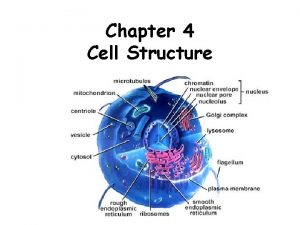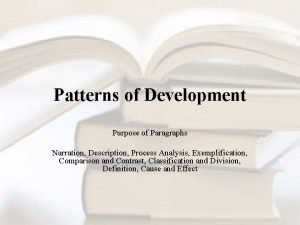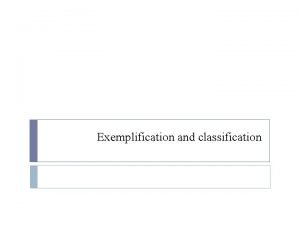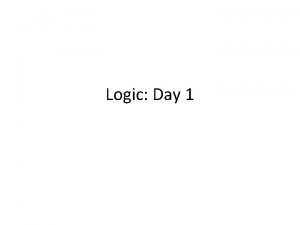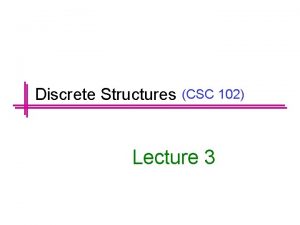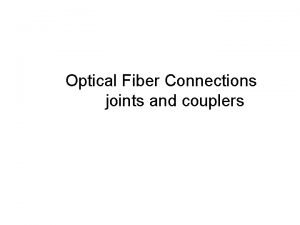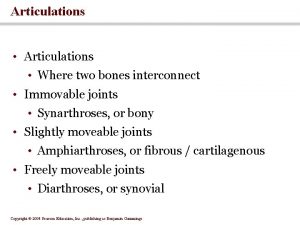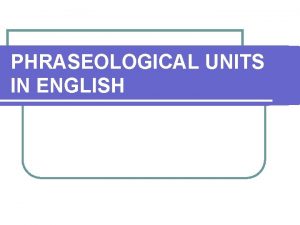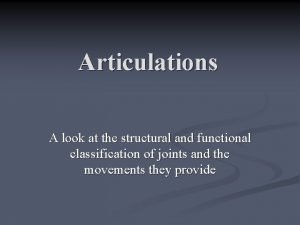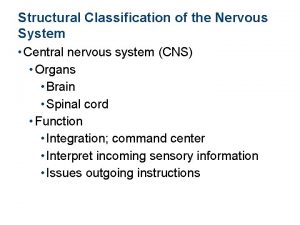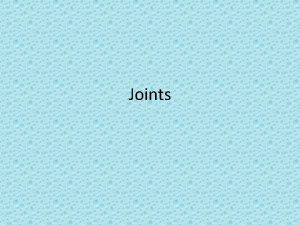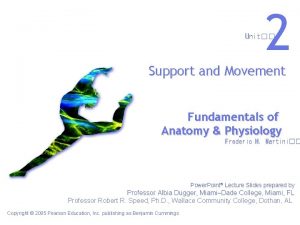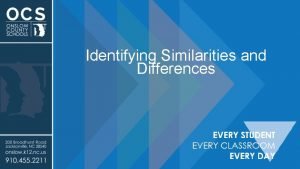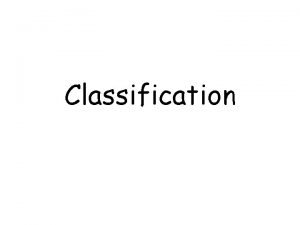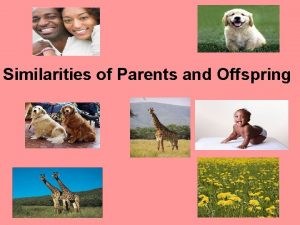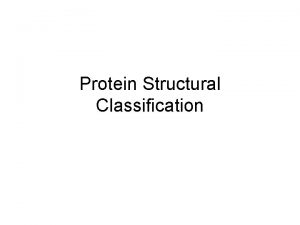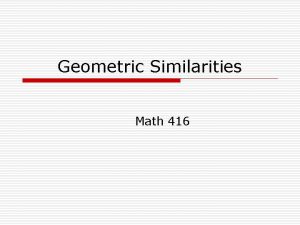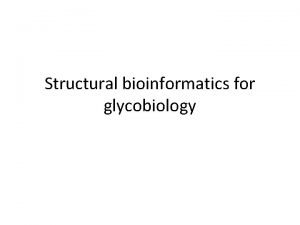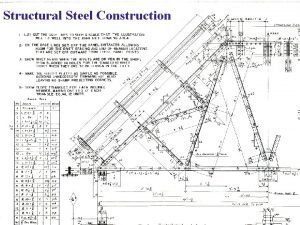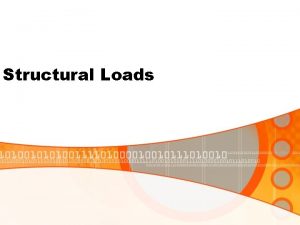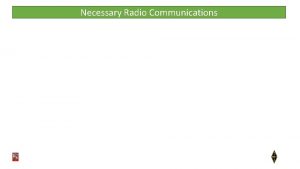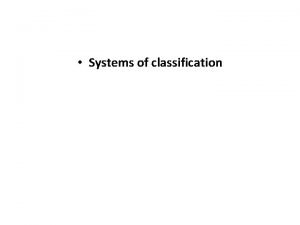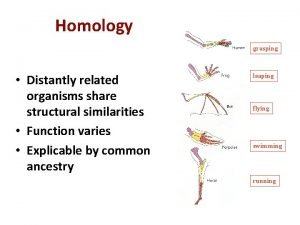Classification Classification and Structural Similarities Classification is necessary




















- Slides: 20

Classification

Classification and Structural Similarities • Classification is necessary for putting organisms into groups. • How is this accomplished? • Homologies in Anatomical Characteristics – example: similar bone and muscle structure of obviously different animals • Chemical homologies – DNA or RNA similarities • Specifics in niches.


• Carolus Linnaeus developed the two naming system in the 18 th century. Together this is the scientific name or Binomial Nomenclature – Composed of two Latin words – First name is the genus and is capitalized – Second name is the description/species and in lowercase. • Example: Homo sapiens, Canis lupus, Pinus ponderosa • Why use the scientific name? – So everyone knows what they are talking about no matter where they are or what language they speak. Naming

Biodiversity • The goal is to correctly categorize every organism into correct domain/kingdom. • Ultimately, the most specific = Species – Group of closely related animals that can breed in nature and produce fertile offspring. – Members of the same species may look different • Dogs may look different but they are the same group – Differences within a species is call variation • Individual variations, geographic variation, and polymorphism

6 Kingdoms • Your first goal is to identify the 6 kingdoms and cite examples that exist in each. • We’ll then look at each kingdom individually and identify features of each.

Kingdoms of Organisms • 1 st based on Cell Type – Prokaryotes – have a lack of membrane bound structures, rigid, form protein like chains, single strand of DNA, plasmids – Eukaryotes – larger, have membrane bond structures, DNA is organized in nucleus, do not have plasmids • 2 nd: Cellular organization – Does it have cell walls? – Is it uni- or multicellular? • 3 rd: Nutrition Source – Auto or Heterotroph? Chemo or photosynthecizing?

Overview of Classification

Kingdom (Domain): Monera/Prokaryotes • Mostly unicellular • Asexual reproduction-one parent (cell division) • Can get energy from the sun, chemicals (autotrophs) or are heterotrophs – Eubacteria (true bacteria) = most use oxygen

Kingdom (Domain): Archaea • Extremophiles. – Are found in “extreme” environments. • Volcanic vents • Glaciers • Deep underwater – Often chemosynthesize.

Kingdom: Protista • Unicellular and multicellular, may be consumers or decomposers, variety of sizes • Eukaryotes • Autotrophy and Heterotrophy – Examples: algae, protozoa (Euglena, amoeba)

Kingdom: Fungi • Heterotrophy • Eukaryotes • Unicellular and multicellular • Absorb small molecules from surroundings (food) generally are decomposers – Example: molds, yeasts and fungi

Kingdom: Plantae – Multicellular eukaryotes that photosynthesis to produce food. (autotrophy) – Very rare but possible some are heterotrophs – The have cellulose in the cell walls, chloroplasts, produce oxygen • Included in this group are ferns, trees, cacti, flowering plants

Kingdom: Animalia • Multicellular eukaryotes, Heterotrophs that range in size • Most are motile, have senses, nervous system. – Vertebrates – have a backbone (birds, dogs, snakes) – Invertebrates – don’t have a backbone (worms and insects)

Kingdoms Contain Phyla • Each kingdom contains more speciic groups called phyla • We will end the year with a study into animal phyla and the systems of animals. • The animal kingdom contains the phyla: – – – – – Porifera (9, 000 species) Cnidaria (10, 000 species) Ctenophora (100 species) Platyhelminthes (20, 000 species) Nematoda (12, 000 species) Mollusca ((110, 000 species) Annelida (12, 000 species) Arthropoda (1 million species) Echinodermata (6, 000 species) Chordata (42, 500 species)


Classification and Change • With new technologies scientists can find different ways of grouping organisms. • Different classifications have different purposes • We use classification systems to help us analyze diversity of the earth for innumerous reasons.

Hierarchies of Classification • • Kingdom Phylum/Division Class Order Family Genus Species • Remembering the order: • King • Philip • Came • Over • For • Great • Soup

Classification of Humans Kingdom Phylum/Division Class Order Family Genus Species Animalia Chordata Mammalia Primates Hominidae Homo sapiens

Independent Practice • Complete the chart… Due Monday • For resources use the blue biology book pgs 604 -610 (symmetry, respiration, etc. ) • For specifics on each phyla, open to the appendix pgs 1042 -1045
 All cells exhibit basic structural similarities
All cells exhibit basic structural similarities Process analysis pattern of development
Process analysis pattern of development Pattern of development
Pattern of development Figure 6-4 the skeleton axial and appendicular divisions
Figure 6-4 the skeleton axial and appendicular divisions Logic
Logic Conditional proposition
Conditional proposition If and only if truth table
If and only if truth table Method of concomitant variation example
Method of concomitant variation example Powers of congress
Powers of congress Powers of congress cartoon
Powers of congress cartoon Necessary life functions and survival needs
Necessary life functions and survival needs Fiber joint closure
Fiber joint closure Necessary life functions anatomy and physiology
Necessary life functions anatomy and physiology Structural classification of joints
Structural classification of joints Structural classification of phraseological units
Structural classification of phraseological units General structure of a synovial joint
General structure of a synovial joint Dr suzana samoilovic
Dr suzana samoilovic Supination inversion
Supination inversion Structural classification of joints
Structural classification of joints Functional classification of joints
Functional classification of joints Humeroulnar joint structural classification
Humeroulnar joint structural classification
